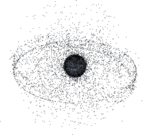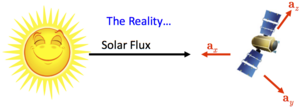Geometric Integration
From ANCS Wiki
What is Geometric Integration?
Geometric integration employs a numerical method that preserves geometric or group properties of the exact differential equation solution trajectory.
Motivation
One prevailing field in which this research is very pertinent is Space Situational Awareness (SSA). The U.S. Air Force is collecting data in order to catalogue Earth orbiting satellites, objects and debris. Accurate tracking of all Earth-orbiting objects is important since their presence can be extremely hazardous to current space missions as well as disruptive for any future mission. This danger can either be passive in the case of debris or active intentional threats. However, the data necessary to estimate the attitude of such objects is sparse as a result of the number of sensors available and the large number of objects in orbit. In particular, for objects in low-Earth orbit (LEO), observation windows may last only a few minutes and opportunities to obtain data are infrequent. As a result, an object's attitude may often need to be propagated very accurately over long time intervals before an update is possible.
In summary, the problem is that
- there are an increasing number of space objects to track
- sensor time per object is limited
- many objects yield infrequent pass opportunities
Advanced estimation techniques require accurate integration during extended propagation intervals when limited observation data is available.
Objective: Employ a Lie group method developed by Crouch and Grossman for the numerical integration of a quaternion parameterized attitude. Its inherent ability to integrate along the unit hypersphere helps to minimize truncation errors while maintaining the quaternion unit norm constraint.
Findings
For small time-steps (< 1s) the CG geometric approach did not perform as well as classical Runge-Kutta (RK) methods. Geometric approaches require more calculations and in this step-size regime, roundoff error and machine precision dominate.
Significant improvement is observed using a fourth-order CG algorithm with larger time-steps (~> 1s). The quaternion norm constraint is maintained essentially to within machine precision and attitude errors are reduced by approximately two orders of magnitude.
Applications
The results are particularly important for high fidelity attitude dynamics. Most perturbing forces, such as drag, solar radiation pressure, magnetic forces and gravity gradients, are a direct function of attitude. Attitude dynamics are much faster than orbital dynamics and therefore dictate the integration time-step in any simulator. Improvements made using a geometric integration method significantly increased accuracy at larger time-steps. The great computational cost of high fidelity models and long-term propagation intervals (days, weeks or months) is therefore reduced.
In applications involving satellite attribute estimation, the size, shape, surface materials and attitude may be unknown. Accurate attitude estimate propagation between measurement updates is essential. Falling well within the domain of SSA, satellite attribute estimation suffers from the same challenges: limited sensor time due to over-tasking, infrequent pass opportunities and longer propagation intervals. While sparse data must be used most effectively, attitude propagation between measurement updates must be as accurate as possible.
References
Andrle, M.S., and Crassidis, J.L., “Geometric Integration of Quaternions,” AIAA/AAS Astrodynamics Specialist Conference, Minneapolis, MN, Aug. 2012, AIAA Paper #2012-4421.



